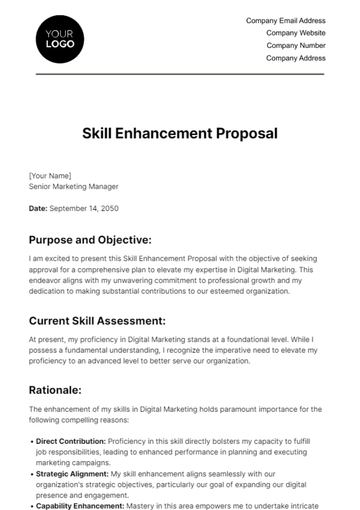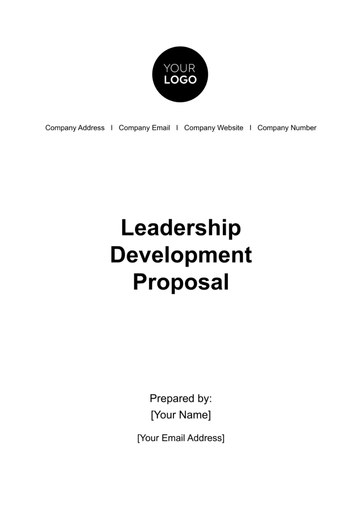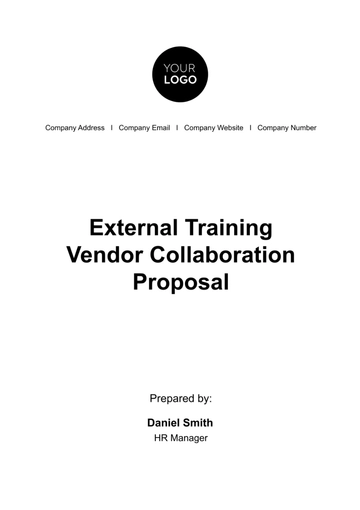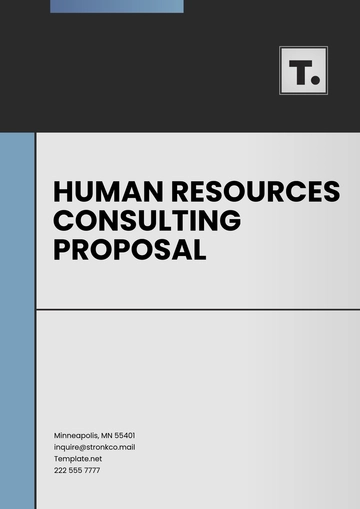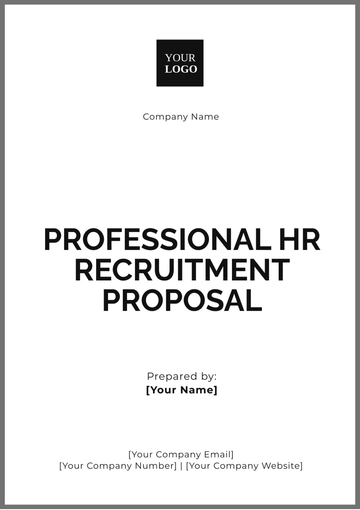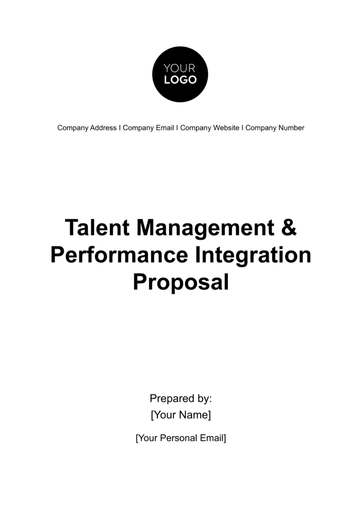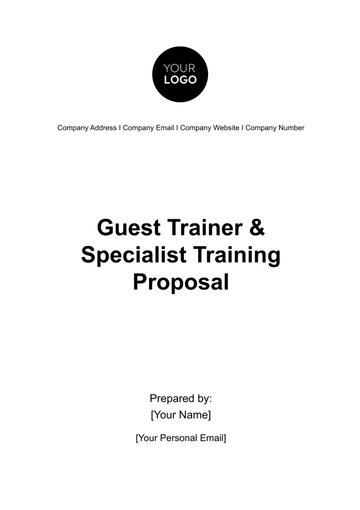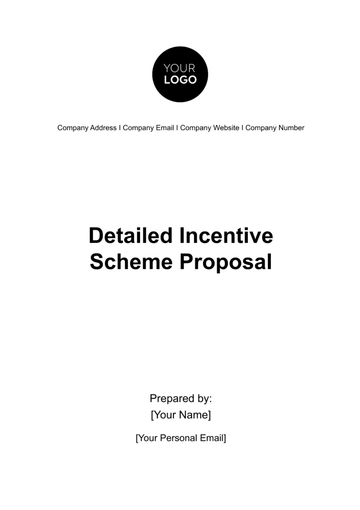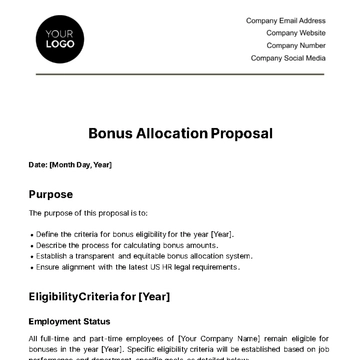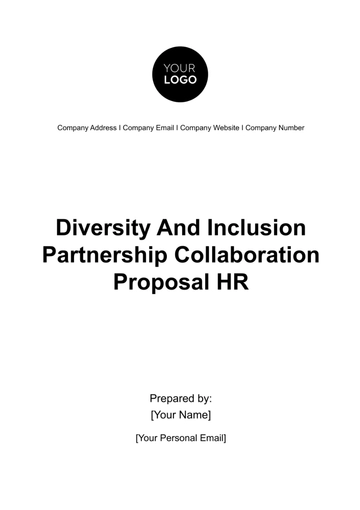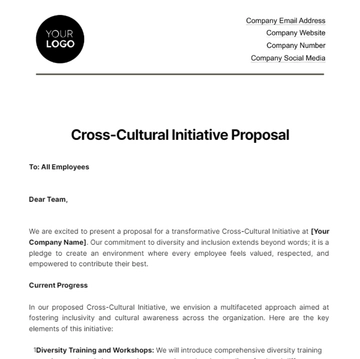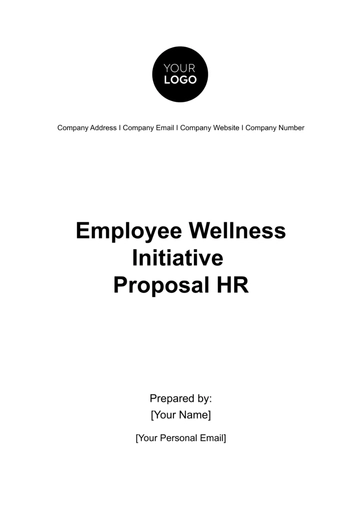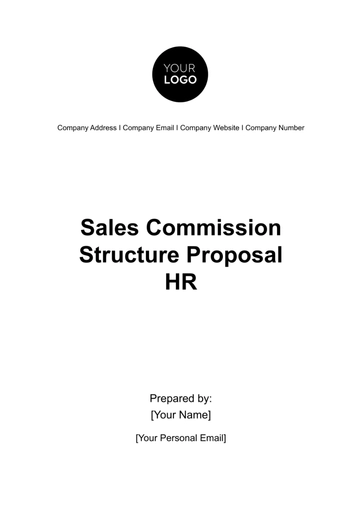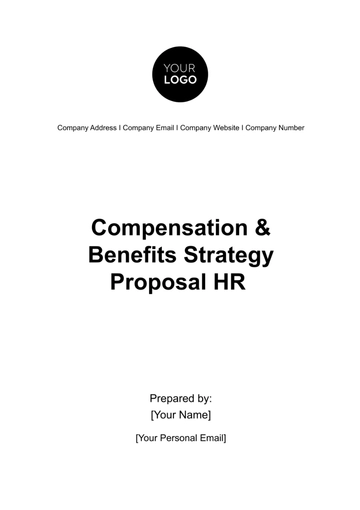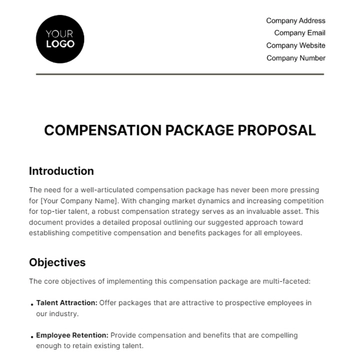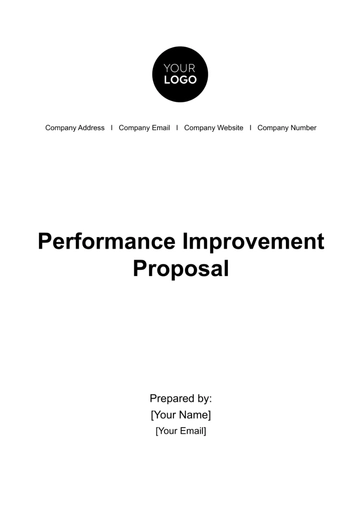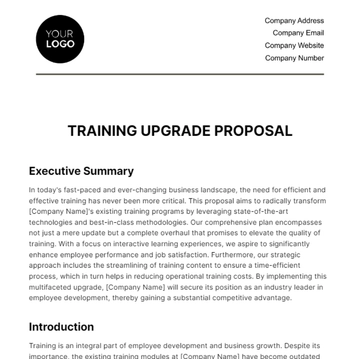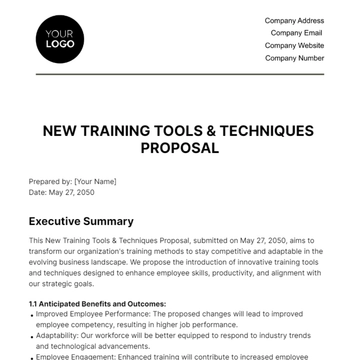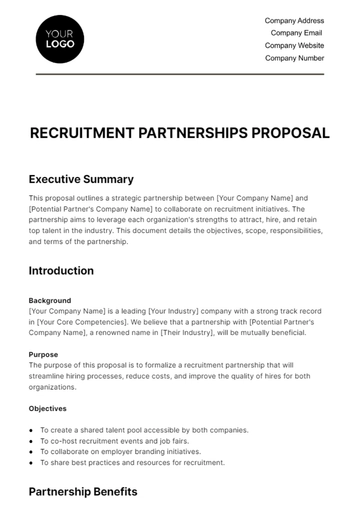Free Detailed Operations Talent Management Proposal
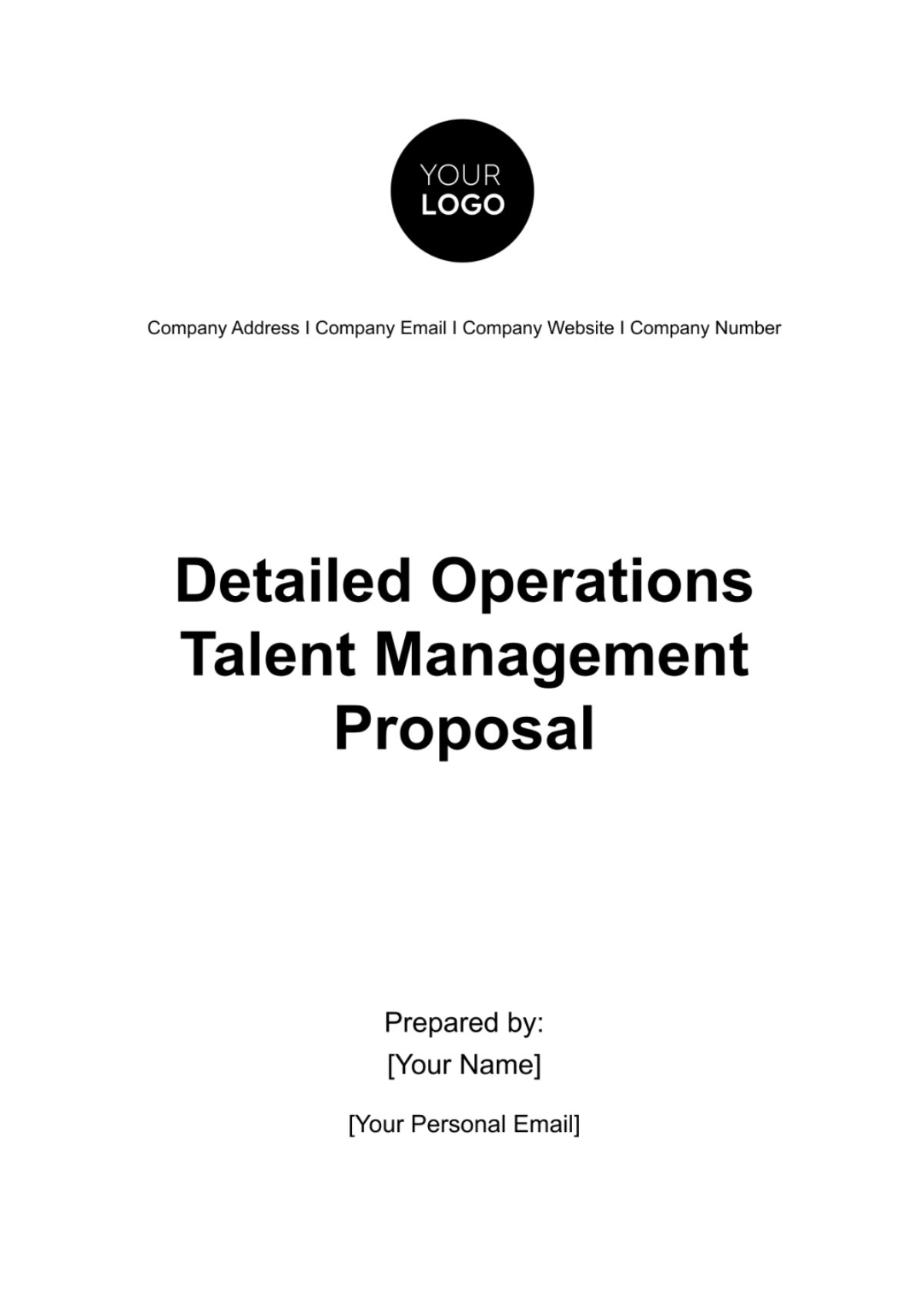
I. Introduction
The purpose of this proposal is to outline comprehensive talent management strategies aimed at optimizing workforce effectiveness and organizational success. By strategically managing talent, [Your Company Name] aims to attract, develop, and retain top talent while fostering a culture of continuous improvement and employee engagement.
II. Objectives of the Talent Management Proposal
The objectives of this Talent Management Proposal are as follows:
Identify and address talent gaps and needs within the organization
Develop recruitment, selection, onboarding, and retention strategies to attract and retain top talent
Enhance employee performance through effective training, development, and performance management systems
Establish succession planning mechanisms to ensure continuity of key roles and positions
Promote diversity, equity, and inclusion initiatives to create a more inclusive workplace culture
III. Current Talent Landscape Analysis
An analysis of the current talent landscape reveals strengths, weaknesses, opportunities, and threats related to workforce composition, skill sets, and employee engagement levels. Key findings include the following:
A. Workforce Demographics:
Age Distribution: The workforce comprises individuals across diverse age groups, with a relatively balanced distribution. However, there is a noticeable concentration of younger employees in entry-level positions.
Gender Diversity: Gender diversity is moderately represented across the organization, with a slight skew towards male employees in technical roles.
Ethnicity and Cultural Backgrounds: The workforce reflects a rich diversity of ethnicities and cultural backgrounds, contributing to a vibrant organizational culture.
Educational Qualifications: Employees possess a varied educational background, ranging from high school diplomas to advanced degrees in specialized fields.
Tenure Within the Organization: The tenure of employees varies, with a mix of long-serving staff members and recent hires contributing to a blend of experience and fresh perspectives.
B. Skill Inventory:
Core Competencies: Employees demonstrate strong competencies in areas such as teamwork, problem-solving, and adaptability, which are crucial for collaborative work environments.
Specialized Skills and Expertise: There is a diverse range of specialized skills and expertise across departments, including technical proficiencies in areas such as software development, marketing analytics, and financial analysis.
Soft Skills: Soft skills such as communication, leadership, and emotional intelligence are valued and cultivated within the workforce, contributing to effective collaboration and employee engagement.
C. Performance Metrics:
Individual and Team Performance Evaluations: Performance evaluations indicate consistently high-performance levels among employees, with a focus on achieving key objectives and delivering quality outcomes.
Key Performance Indicators (KPIs): KPIs related to productivity, quality, and customer satisfaction are tracked regularly, providing insights into employee performance and areas for improvement.
Feedback from Performance Reviews: Feedback from performance reviews highlights areas of strength and areas for development, facilitating ongoing professional growth and skill enhancement.
D. Talent Utilization:
Alignment of Employee Skills with Organizational Goals: Efforts are made to align employee skills and competencies with organizational goals and objectives, ensuring that resources are effectively utilized to drive business success.
Utilization Rates: Talent utilization rates vary across departments, with some teams experiencing higher workloads and others with the capacity for additional responsibilities.
Identification of Underutilized or Overburdened Talent: Strategies are being developed to identify and address instances of underutilization or overburdening of talent, aiming to optimize resource allocation and workload distribution.
E. Employee Engagement and Satisfaction:
Employee Satisfaction Surveys: Regular employee satisfaction surveys provide insights into workforce sentiment, identifying areas of satisfaction and areas requiring improvement.
Feedback from Engagement Initiatives: Feedback from engagement initiatives such as team-building activities, recognition programs, and wellness initiatives is positive, indicating high levels of employee engagement.
Attrition Rates and Turnover Trends: Attrition rates and turnover trends are monitored closely to identify potential retention challenges and implement targeted retention strategies.
F. Market Analysis:
Comparison with Industry Benchmarks: Internal talent is benchmarked against industry standards to assess competitiveness and identify areas for skill development and talent acquisition.
Emerging Skill Requirements: Market analysis reveals emerging skill requirements in the industry, informing talent development initiatives and recruitment strategies.
Analysis of Talent Availability: Talent availability and competition in the industry are evaluated to anticipate talent acquisition challenges and opportunities for talent sourcing.
IV. Identification of Talent Gaps and Needs
Based on the analysis, talent gaps and needs have been identified in the following areas:
Technical Skills:
Gap: There is a need for enhanced proficiency in emerging technologies such as artificial intelligence (AI), machine learning (ML), and data analytics, particularly among non-technical staff.
Needs: Training programs and upskilling initiatives focused on technical skills development will be prioritized to bridge the gap and ensure alignment with evolving industry demands.
Leadership Development:
Gap: A shortage of mid-level managers with strong leadership competencies and decision-making skills has been identified, posing challenges for succession planning and team management.
Needs: Leadership development programs will be implemented to nurture leadership talent from within the organization, emphasizing skills such as strategic thinking, conflict resolution, and mentorship.
Cross-functional Collaboration:
Gap: Siloed working practices have resulted in limited collaboration and knowledge sharing across departments, hindering innovation and cross-functional projects' success.
Needs: Initiatives to foster a culture of collaboration and cross-functional teamwork will be introduced, including team-building activities, interdepartmental projects, and communication workshops.
Customer-centric Skills:
Gap: A lack of customer-centric skills and mindset among frontline staff has been observed, impacting customer satisfaction and retention rates.
Needs: Customer service training programs focusing on active listening, empathy, and problem-solving will be implemented to enhance staff's ability to meet and exceed customer expectations.
Change Management Expertise:
Gap: Employees demonstrate resistance to change and limited adaptability in response to organizational changes and industry disruptions.
Needs: Change management training will be provided to equip employees with the skills and strategies needed to navigate change effectively, fostering a culture of resilience and agility.
Digital Literacy:
Gap: A significant portion of the workforce lacks basic digital literacy skills required to leverage digital tools and platforms effectively in their roles.
Needs: Digital literacy training will be rolled out to enhance employees' proficiency in using digital technologies for communication, collaboration, and productivity improvement.
Soft Skills Enhancement:
Gap: While employees possess strong technical skills, there is a need for further development of soft skills such as communication, teamwork, and conflict resolution.
Needs: Soft skills training workshops and coaching sessions will be conducted to enhance employees' interpersonal skills, emotional intelligence, and resilience in diverse work environments.
Diversity and Inclusion Awareness:
Gap: Limited awareness and understanding of diversity and inclusion principles have been observed, leading to potential biases and inequities in workplace interactions and decision-making.
Needs: Diversity and inclusion training programs will be implemented to promote awareness, sensitivity, and inclusivity, fostering a more equitable and welcoming work environment for all employees.
V. Recruitment and Selection Strategies
To address talent gaps and attract top talent, the following recruitment and selection strategies will be implemented:
Job Advertisements
Employee Referral Programs
Recruitment Agencies
Social Media Recruitment
Job Fairs and Career Events
Internal Job Postings
Networking and Professional Associations
Talent Pools and Database Searches
Campus Recruitment
Headhunting or Executive Search Firms
VI. Onboarding and Orientation Processes
Effective onboarding and orientation processes will be implemented to ensure new hires are seamlessly integrated into the organization. Key components include:
Pre-employment communication and preparation
Structured orientation programs
Introduction to team members and key stakeholders
Introduction to company facilities and resources
Review of job responsibilities and expectations
Training on essential tools and software
Introduction to company values and mission
Overview of safety protocols and emergency procedures
Mentorship and buddy programs
Ongoing feedback and support
VII. Training and Development Programs
Comprehensive training and development programs will be established to enhance employee skills and competencies. Key initiatives include:
A. Technical Skills Training:
Job-specific training workshops or seminars to improve technical competencies.
Certification programs for relevant industry qualifications or specialized skills.
Cross-training initiatives to broaden employees' skill sets and versatility within the organization.
B. Leadership and Management Development:
Leadership training programs to cultivate managerial skills, such as communication, decision-making, and conflict resolution.
Mentoring and coaching programs pairing junior employees with experienced leaders to foster career development and leadership potential.
Management academies offering comprehensive training for emerging and established leaders on strategic planning, team management, and performance optimization.
C. Soft Skills Enhancement:
Communication skills workshops focusing on effective verbal and written communication, active listening, and interpersonal skills.
Time management and organizational skills training to improve productivity, prioritize tasks, and meet deadlines.
Emotional intelligence and resilience-building programs to support employee well-being, stress management, and adaptability in the workplace.
D. Continuous Learning Initiatives:
Access to online learning platforms, e-courses, and educational resources to facilitate self-directed learning and skill development.
Lunch-and-learn sessions, brown bag seminars, or webinars covering emerging industry trends, best practices, and professional development topics.
Participation in conferences, industry events, and networking opportunities to expand knowledge, share insights, and stay updated on industry advancements.
E. Personalized Development Plans:
Individualized development plans collaboratively created between employees and their managers, aligning training and development activities with career aspirations and organizational goals.
Regular performance reviews and feedback sessions to assess progress, identify learning needs, and adjust development plans accordingly.
Opportunities for job rotations, stretch assignments, or special projects to provide experiential learning and career growth opportunities.
VIII. Performance Management Systems
An effective performance management system will be implemented to align employee goals with organizational objectives and provide regular feedback and coaching. Key components include:
A. Goal Setting and Alignment:
Collaborative goal-setting processes involving employees and their managers to establish SMART (Specific, Measurable, Achievable, Relevant, Time-Bound) objectives.
Ensuring alignment between individual goals and organizational objectives to promote a shared vision and strategic direction.
Regular review and adjustments of goals to adapt to changing business priorities and personal development needs.
B. Continuous Feedback and Coaching:
Implementing regular feedback mechanisms, including one-on-one check-ins, quarterly performance reviews, and real-time feedback tools.
Encouraging a coaching culture where managers provide constructive feedback, recognize achievements, and identify opportunities for improvement.
Facilitating open communication channels for employees to voice concerns, seek guidance, and contribute ideas for personal and professional development.
C. Performance Appraisals and Evaluations:
Conducting comprehensive performance appraisals at regular intervals, assessing both quantitative and qualitative aspects of employee contributions.
Utilizing a well-defined performance rating system that considers key performance indicators, competencies, and behavioral traits.
Providing actionable insights and development plans based on performance evaluations to guide employees in their career progression.
D. Recognition and Rewards:
Establishing a structured recognition program to acknowledge outstanding achievements, milestones, and contributions.
Implementing a fair and competitive rewards system, including merit-based salary increases, bonuses, and non-monetary incentives.
Linking recognition and rewards to the attainment of individual and team goals, fostering a culture of high performance and engagement.
E. Professional Development Opportunities:
Identifying learning and development needs through performance assessments to inform personalized professional development plans.
Offering skill-building opportunities, training programs, and workshops to address performance gaps and enhance employee capabilities.
Supporting employees in creating individual development plans that align with their career aspirations and contribute to organizational objectives.
IX. Employee Engagement Initiatives
Employee engagement initiatives will be implemented to foster a positive work environment and enhance employee satisfaction and commitment. Key initiatives include:
Employee recognition programs and appreciation events
Employee feedback mechanisms and surveys
Opportunities for involvement in decision-making processes
Work-life balance initiatives and wellness programs
X. Diversity and Inclusion Strategies
Diversity and inclusion strategies will be developed to create a more inclusive and equitable workplace culture. Key initiatives include:
Implementing diversity training and awareness programs
Establishing employee resource groups and affinity networks
Reviewing and revising HR policies and practices to promote inclusivity
Monitoring and addressing diversity metrics and disparities.
Professional development opportunities, such as workshops, seminars, and conferences
Employee resource groups or affinity networks to foster inclusivity and belonging
Social events and team-building activities to strengthen interpersonal relationships
Cross-functional projects and collaboration opportunities to promote teamwork
Flexible work arrangements, including remote work options or flexible scheduling
Mentorship and coaching programs to support career growth and skill development
XI. Retention Strategies
Retention strategies will be implemented to reduce turnover and retain top talent within the organization. Key initiatives include:
Conducting exit interviews to identify reasons for turnover
Implementing flexible work arrangements and career development opportunities
Providing competitive compensation and benefits packages
Creating a positive and supportive work environment
Offering opportunities for advancement and career growth within the organization
Providing regular performance feedback and recognition for achievements
Implementing employee retention bonuses or incentive programs
Offering opportunities for skill development and training to enhance job satisfaction
Encouraging work-life balance through policies such as paid time off and parental leave
Providing opportunities for employees to participate in decision-making processes and contribute to the company's direction
XII. Budget and Resource Allocation
A budget and resource allocation plan will be developed to support the implementation of talent management initiatives. The table below outlines the estimated costs for various aspects of the talent management program:
Category | Description | Amount |
|---|---|---|
Recruitment Costs | Advertising, hiring platforms, recruitment agencies | $20,000.00 |
XIII. Implementation Timeline
An implementation timeline will be established to guide the rollout of talent management initiatives. The details of the activities and their respective start and end dates are showcased in the table below.
Activity | Start Date | End Date |
|---|---|---|
Needs Analysis | 01/01/2023 | 01/15/2023 |
XIV. Monitoring and Evaluation Processes
Monitoring and evaluation processes will be implemented to assess the effectiveness of talent management initiatives and make adjustments as needed. Key metrics and evaluation criteria include:
Regular performance reviews and evaluations
Feedback mechanisms from employees and managers
Key performance indicators (KPIs) tracking
Quarterly or annual talent assessments
Surveys on training effectiveness and employee satisfaction
Review of turnover rates and retention metrics
XV. Continuous Improvement Measures
Continuous improvement measures will be implemented to refine and enhance talent management processes over time. Key actions include:
Regular reviews and updates of talent management policies and procedures
Benchmarking against industry best practices and performance metrics
Soliciting feedback from employees and stakeholders for process improvement opportunities
Ongoing training and development for HR and management staff on talent management best practices
- 100% Customizable, free editor
- Access 1 Million+ Templates, photo’s & graphics
- Download or share as a template
- Click and replace photos, graphics, text, backgrounds
- Resize, crop, AI write & more
- Access advanced editor
Strengthen your talent management practices this Template.net's Detailed Operations Talent Management Proposal Template, available at Template.net. This customizable and editable proposal, accessible via Template.net's AI Editor Tool, enables you to assess current talent needs, propose recruitment and training programs, and establish performance management processes. Unlock the potential of your workforce with Template.net!
You may also like
- Business Proposal
- Research Proposal
- Proposal Request
- Project Proposal
- Grant Proposal
- Photography Proposal
- Job Proposal
- Budget Proposal
- Marketing Proposal
- Branding Proposal
- Advertising Proposal
- Sales Proposal
- Startup Proposal
- Event Proposal
- Creative Proposal
- Restaurant Proposal
- Blank Proposal
- One Page Proposal
- Proposal Report
- IT Proposal
- Non Profit Proposal
- Training Proposal
- Construction Proposal
- School Proposal
- Cleaning Proposal
- Contract Proposal
- HR Proposal
- Travel Agency Proposal
- Small Business Proposal
- Investment Proposal
- Bid Proposal
- Retail Business Proposal
- Sponsorship Proposal
- Academic Proposal
- Partnership Proposal
- Work Proposal
- Agency Proposal
- University Proposal
- Accounting Proposal
- Real Estate Proposal
- Hotel Proposal
- Product Proposal
- Advertising Agency Proposal
- Development Proposal
- Loan Proposal
- Website Proposal
- Nursing Home Proposal
- Financial Proposal
- Salon Proposal
- Freelancer Proposal
- Funding Proposal
- Work from Home Proposal
- Company Proposal
- Consulting Proposal
- Educational Proposal
- Construction Bid Proposal
- Interior Design Proposal
- New Product Proposal
- Sports Proposal
- Corporate Proposal
- Food Proposal
- Property Proposal
- Maintenance Proposal
- Purchase Proposal
- Rental Proposal
- Recruitment Proposal
- Social Media Proposal
- Travel Proposal
- Trip Proposal
- Software Proposal
- Conference Proposal
- Graphic Design Proposal
- Law Firm Proposal
- Medical Proposal
- Music Proposal
- Pricing Proposal
- SEO Proposal
- Strategy Proposal
- Technical Proposal
- Coaching Proposal
- Ecommerce Proposal
- Fundraising Proposal
- Landscaping Proposal
- Charity Proposal
- Contractor Proposal
- Exhibition Proposal
- Art Proposal
- Mobile Proposal
- Equipment Proposal
- Student Proposal
- Engineering Proposal
- Business Proposal
